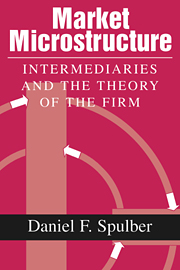Book contents
- Frontmatter
- Contents
- Preface and acknowledgments
- Introduction
- Part I Market microstructure and the intermediation theory of the firm
- Part II Competition and market equilibrium
- Part III Intermediation versus decentralized trade
- Part IV Intermediation under asymmetric information
- Part V Intermediation and transaction-cost theory
- Part VI Intermediation and agency theory
- Conclusion
- References
- Index
Introduction
Published online by Cambridge University Press: 18 December 2009
- Frontmatter
- Contents
- Preface and acknowledgments
- Introduction
- Part I Market microstructure and the intermediation theory of the firm
- Part II Competition and market equilibrium
- Part III Intermediation versus decentralized trade
- Part IV Intermediation under asymmetric information
- Part V Intermediation and transaction-cost theory
- Part VI Intermediation and agency theory
- Conclusion
- References
- Index
Summary
The intermediation theory of the firm provides an explanation for why firms exist. Firms are formed when intermediated exchange provides greater gains from trade than direct exchange between consumers and suppliers. The theory also helps to explain how markets work. Markets reach equilibrium through strategic pricing and contracting by intermediaries.
Under some circumstances, intermediaries may have advantages over direct exchange in a number of activities:
Reducing transaction costs.
Pooling and diversifying risk.
Lowering costs of matching and searching.
Alleviating adverse selection.
Mitigating moral hazard and opportunism.
Supporting commitment through delegation.
In this introductory chapter, I illustrate the intermediation theory of the firm with a series of basic examples. Later chapters present a more complete analysis of the models that underlie these examples.
Some advantages derive from coordination economies: the firm is recognized as a central place of exchange, thus reducing costs of search. Other advantages derive from economies of scale and scope in subtle ways. For example, because an intermediary can handle a higher volume of transactions than individual buyers and sellers, the intermediary is able to reduce risk through pooling and diversification. Other advantages stem from longevity and economic incentives to build a reputation. In particular, intermediaries who are able to make credible commitments bring advantages over contracts between buyers and sellers that are subject to renegotiation.
The intermediation theory of the firm
In this section, I illustrate the intermediation theory of the firm by means of a simple example.
- Type
- Chapter
- Information
- Market MicrostructureIntermediaries and the Theory of the Firm, pp. xiii - xxxPublisher: Cambridge University PressPrint publication year: 1999



